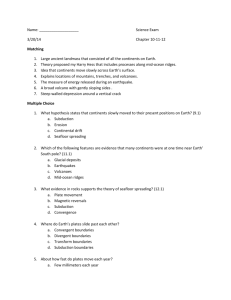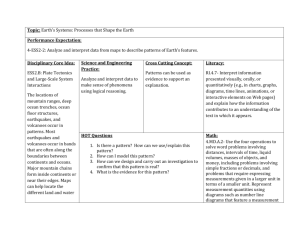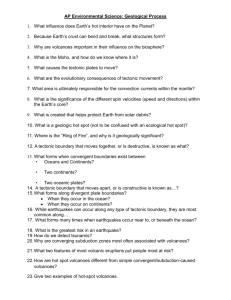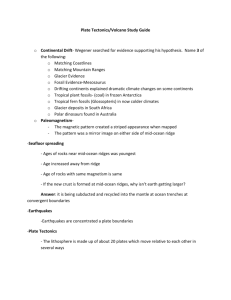PTReview Q`s
advertisement
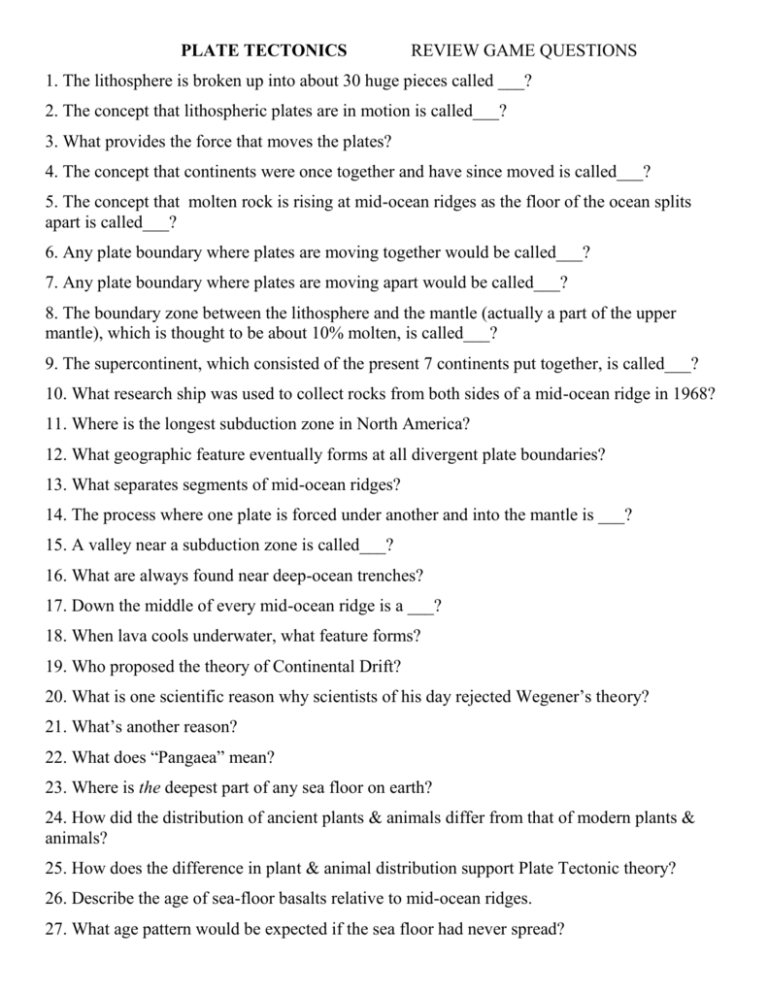
PLATE TECTONICS REVIEW GAME QUESTIONS 1. The lithosphere is broken up into about 30 huge pieces called ___? 2. The concept that lithospheric plates are in motion is called___? 3. What provides the force that moves the plates? 4. The concept that continents were once together and have since moved is called___? 5. The concept that molten rock is rising at mid-ocean ridges as the floor of the ocean splits apart is called___? 6. Any plate boundary where plates are moving together would be called___? 7. Any plate boundary where plates are moving apart would be called___? 8. The boundary zone between the lithosphere and the mantle (actually a part of the upper mantle), which is thought to be about 10% molten, is called___? 9. The supercontinent, which consisted of the present 7 continents put together, is called___? 10. What research ship was used to collect rocks from both sides of a mid-ocean ridge in 1968? 11. Where is the longest subduction zone in North America? 12. What geographic feature eventually forms at all divergent plate boundaries? 13. What separates segments of mid-ocean ridges? 14. The process where one plate is forced under another and into the mantle is ___? 15. A valley near a subduction zone is called___? 16. What are always found near deep-ocean trenches? 17. Down the middle of every mid-ocean ridge is a ___? 18. When lava cools underwater, what feature forms? 19. Who proposed the theory of Continental Drift? 20. What is one scientific reason why scientists of his day rejected Wegener’s theory? 21. What’s another reason? 22. What does “Pangaea” mean? 23. Where is the deepest part of any sea floor on earth? 24. How did the distribution of ancient plants & animals differ from that of modern plants & animals? 25. How does the difference in plant & animal distribution support Plate Tectonic theory? 26. Describe the age of sea-floor basalts relative to mid-ocean ridges. 27. What age pattern would be expected if the sea floor had never spread? 28. Name 3 continents that would fit together like a puzzle. 29. How do fossil crocodiles provide evidence that continents have drifted? 30. What has happened to earth’s magnetic field many times in the geologic past? 31. What causes the “zebra stripe” pattern of paleomagnetism on the sea floor? 32. What would the pattern of paleomagnetism on the sea floor be like if plates had never moved? 33. Describe the age pattern of the Hawaiian hot spot volcanoes in relation to the present-day location of the hot spot. 34. What causes this pattern? 35. What would Hawaii be like if the plates had never moved? 36. What was Alfred Wegener’s occupation? 37. What has happened to all sea-floor sediments older than 250 million years old, so that none are found today? 38. In which compass direction is the North American continent now moving? 39. What are 2 geographic features associated with subduction zones? 40. Why is there a bend in the Hawaiian Island/Emperor Seamount chain? 41. How are the rocks of hot spot volcanoes different than those of subduction zone volcanoes? 42. Name a volcanic island arc. 43. Name 2 subduction zone volcanoes. 44. What are the 2 most likely explanations for evidence of ancient glaciers that were once on Africa where palm trees now thrive? 45. What causes the rocks of hot spot volcanoes to be different from those of subduction zone volcanoes? 46. What will probably happen to the Mediterranean Sea within 100 million years? 47. Name a transform fault. 48. Landmasses that formed far from the continent of which they are now a part are called___? 49. Mountains in Scotland & Scandinavia are very similar in age, rock type and structure to what mountains in North America? 50. The process of adding rock material to the edges of continents as a result of plate collisions is called___? 51. Where does a mid-ocean ridge rise conspicuously above sea level? 52. Where are the world’s deepest-focus earthquakes? 53. Name 2 mountain ranges associated with subduction zones. 54. India is on the same plate as what other continent? 55. How can plate tectonics lead to extinction of plant and animal species? 56. What is Panthallasa? 1. tectonic plates 2. Plate Tectonic theory 3. Convection in the mantle, driven by the heat of the core. 4. Continental drift 5. Sea Floor Spreading 6. convergent 7. divergent 8. the asthenosphere 9. Pangaea 10. the Glomar Challenger 11. the Aleutian Trench with the Aleutian Island Arc. 12. rift valley at least, or perhaps a mid-ocean ridge. 13. transform faults 14. subduction 15. deep-ocean trench 16. volcanoes 17. rift valley 18. pillow lava 19. Alfred Wegener 20. He couldn’t explain what force could move continents. 21. He couldn’t explain how continents could plow through ocean floors without both getting messed up, when both are made of rock. 22. all land 23. Marianas Trench in the Pacific Ocean 24. Today, different plants and animals are found on different continents. Fossils from long ago seem to show that the same plants and animals were on (what are now) different continents. 25. If the continents were put back together, the fossil distribution pattern would be like it is today. 26. The farther from the ridge, the older 27. The whole sea floor would be the same age - the age of the Earth itself. 28. North America, South America, Eurasia, and Africa would all fit. 29. Fossils of tropical crocodiles are found in non-tropical places. 30. It reversed. 31. As the sea floor spreads, reversing magnetism is recorded in the rock. 32. It would be all the same direction. 33. They get older as you get further from the hot spot. 34. Plate moving over a stationary hot spot. 35. There’d be one giant volcano. 36. meteorologist 37. They’re all subducted back into the mantle. 38. west 39. deep ocean trenches, volcanoes 40. The Pacific plate changed direction. 41. Hot spot volcanoes are basaltic shield cones with gentle eruptions, subduction volcanoes are granitic composite cones that often erupt violently. 42. Aleutians, Mariana Islands, Philippines, or the Lesser Antilles in the Caribbean 43. Mt St Helens, Mt Rainier, Mt Vesuvius, Mt Pinatubo, Krakatau, Etna, Mt Usu, Mt Fuji, etc. 44. a. The whole world was once much colder. b. Continents with old glacier marks moved to more tropical places. 45. Magma from hot spot volcanoes comes directly from the mantle, while subduction zone magma includes mostly melted sediments. 46. It may close up as Africa moves north into Europe. 47. San Andreas in CA, Anatolian fault in Turkey 48. exotic terranes 49. Appalachians 50. accretion 51. Iceland 52. near subduction zones 53. Himalayans, Cascades, Andes 54. Australia 55. Climate patterns change, shorelines disappear 56. ocean surrounding Pangaea.
